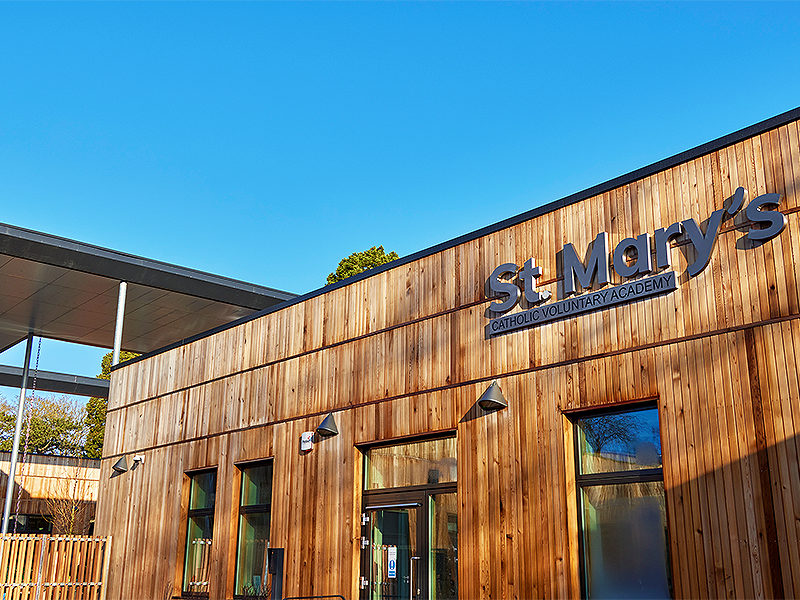Simon Butler, Managing Director – Building Central at Tilbury Douglas, discusses the innovations used to successfully complete the greenest primary school in the country.
Tilbury Douglas
At Mary’s Catholic Voluntary (CV) Academy in Derby, which was selected by the Department for Education (DfE) in 2021 as an innovative pilot scheme, following a devastating arson attack that destroyed the previous school, is now complete. The pioneering new eco building, which is part of the St Ralph Sherwin Trust, welcomed pupils and staff in December 2023.
The new school embraces key Construction Playbook themes, being net-zero carbon in operation, low embodied carbon and a modern methods of construction (MMC) exemplar, including a fully-embraced digital strategy.
Biophilic – connecting with nature
The biophilic design focuses on connecting the internal environment with nature, with the goal of promoting physical and mental health. Slightly sloping, the site is surrounded by mature trees of varying species.
Moving away from the typical, single building accommodation arrangement, St Mary’s CV Academy is distinctive in plan. Comprising five single-storey buildings, linked by a large covered central walkway, the plan promotes high levels of natural light and access to the surrounding landscape.
As part of the landscape strategy, the site has been planted with 96 new trees, many of which will be semi-mature to help the school become quickly embedded in the biophilic landscape. Additional landscape features include rain gardens, season bulb planting and meadow grasses.
Learning from and in nature is an important theme for this academy and will be supported through the built environment. For example, each classroom features doors to courtyards, increasing access to the outside. The natural landscape hopes to capture the imagination of pupils, aiding their exploration of their natural surroundings, boosting creativity and reducing stress.
In this digital age, St Ralph Sherwin Academy Trust is keen to reconnect pupils with the natural world and promote learning in the landscape. This aims to work on a number of sensory levels, be it managing risk though play and adventure, or appreciating the dependencies of flora and fauna through biodiversity and horticulture.
As a Catholic school, faith areas, such as a chapel and memorial garden, will work harmoniously with the forest school and biophilic principles in a holistic design that unites nature, education and spirituality.
MMC
The speed at which the project was delivered was mainly down to the Innovare Structural Insulated Panel (SIP) system; an interlocking, load-bearing system that is manufactured off site and guarantees performance in terms of thermal insulation, fire safety and acoustics. It also uses environmentally-friendly materials and finishes, alongside efficient processes that concentrate on minimal waste and recycling offcuts.
The floor and ceiling SIPs strategy will not only support the school in its low embodied carbon aspirations, but will also make maintenance easier moving forwards, omitting suspended ceilings and cavity MEP.
Low-carbon engineering
Considering the building’s embodied lifecycle has been an important part of the design and preconstruction of this special project, alongside the operational energy strategy, devised by Cundall, which will deliver net-zero carbon in use.
Our engineering team undertook the design and installation of this highly thermally-efficient building. This included significant amounts of full-height glazing to maximise the benefits of natural daylight. Other key mechanical, electoral and plumbing (MEP) strategies included the use of heat pumps, photovoltaics (PV) and intelligent natural ventilations technologies.
Post-occupant support will, together with enhanced metering, play a key role in optimising the future operating performance of this building and provide essential data to help inform future standards.
The roofs of the five blocks are currently being prepared for either PV or wildflower green roof installations that will contribute to the school’s energy loads; albeit the core of the energy strategy is to reduce the need for heat and light in the first instance.
Community engagement
Alongside the build programme, our social value commitments have been a priority with a complete social value plan being delivered in association with the project and stakeholders.
Amongst local spend, some of the highlights have included several apprenticeship opportunities; work placements from University of Derby, T-Level placements, as well as summer placements for local young people interested in construction careers.
Looking ahead
To have completed this project is a great achievement by all those involved with this important scheme.
Amanda Greaves, Executive Headteacher at St Mary’s, said: “This move is a hugely-positive and long-awaited milestone and we know that pupils and staff will be excited to finally return to Broadway, to a brand-new biophilic school.”
Matt Gage, Programme Director at the DfE, added: “We are immensely proud of the role our Risk Protection Arrangement has played in supporting this scheme and building back a better school out of the tragedy of the fire that occurred in 2021. It is a testament to the difference we can make when we work together as a joined-up schools sector.”
As the UK’s greenest primary school, and first biophilic school, this DfE pilot project will play a key role is setting future standards for eco-friendly schools of the future. We know the pupils, teachers and wider community will really benefit from utilising the new facilities.
Moving forwards, the school will be part of a research programme with the University of Derby, who will be monitoring the various innovative elements of the building and reporting pupil health and wellbeing results. This will help provide lessons learned to the DfE and future schools.











